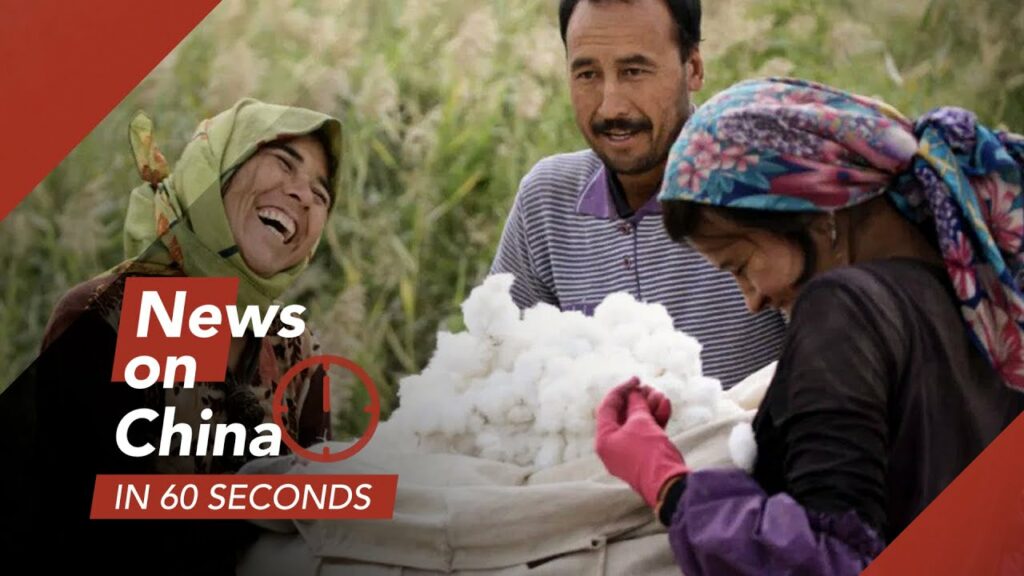

Xinjiang cotton workers, 2021 [Sohu]
Subscribe to News on China. The digest is published every Saturday in English, Spanish, Portuguese and French.
Watch the News on China in 60 Seconds by clicking on the image above, and subscribe to our YouTube channel.
Read the News on China: Africa Weekly in English, Spanish, Portuguese and French.
Dear reader,
This week, our conversation with Daniel Dumbrill looks at the opening up of China’s financial market to international investment and the “de-Americanization” of culture among Chinese youth, especially with the development of domestic cinema. Watch it here.
We also have a Twitter account (@DongshengNews). Please check it out, follow and share!

Geopolitics
China signs 25-year strategic cooperation deal with Iran, whose economy suffers from US sanctions
While partnership details are yet to be disclosed, China could invest up to US $400 billion with emphasis on infrastructure in exchange for Iranian oil; between 2014-20, bilateral trade fell (US $52-20 billion) due to US sanctions
South China Morning Post, 27.03.2021
New York Times, 27.03.2021
NGO supporting and overseeing the cotton industry (BCI) encourages boycott of Xinjiang producers for alleged use of “forced labor”
Shanghai branch investigated and denied accusations, but headquarters (Geneva and London) of USAID-funded NGO maintained the boycott, expected to exclude 500,000 tons of Xinjiang cotton from global supply chains
Chinese officials declare “era of bullying” over in response to Western government and corporate sanctions on Xinjiang
Xinjiang government compares coordinated sanctions by EU, US, UK, Canada and international brands (H&M, Nike, Adidas) to treatment by Western powers during “century of humiliation”; actions jeopardize Xinjiang cotton workers’ livelihoods

People’s Life and Culture
Chinese social media campaigns erupt in support of Xinjiang cotton, boycotting international brands linked to Better Cotton Initiative
Communist Youth League, official media and netizens are leading the boycott movement, celebrities terminate corporate contracts and #ISupportXinjiangCotton hashtag received six billion Weibo views
Xinjiang’s capital Ürümqi sees population surge in region with fastest growing and youngest demographic in China
Ürümqi’s population grew from 1.5 to 3.5 million people (1990-2018) as youth migrated for jobs and living standards, but rapid expansion strains natural environment; Xinjiang’s Uygur growth rate (25%) surpassed Han people (2%) and regional total (14%), 2010-18
South China Morning Post, 30.03.2021
Global Times, 07.01.2021

Economy
Xinjiang produces 87% of cotton in China, largest global consumer (8 million tons/year) and second largest producer (5.2 million tons/year)
International Xinjiang cotton boycott could be offset by domestic consumption (Xinjiang supplies 67% of total) with rising Chinese brands; Chinese textile exports (US $162.9 billion) increased 30.4% year-on-year in 2020
China’s flat steel manufacturing set to boom as global demand rises and pollution controls push out competition
Hot rolled coil (cars, appliances, machinery) prices grew 50% over past six months and increases seen in industrial output (+35.1%), exports of shipping-containers (+100%) and vehicles (+85%) January-February year-on-year; responsible for 15% of China’s pollution, steel industry faces output cuts

Agriculture and Environment
World’s largest oil refiner Sinopec will add hydrogen to 1,000 gas stations by 2025 as part of low-carbon transformation
With 30,700 operating fuel stations, Sinopec aims to reach peak emissions by 2025 and carbon-neutrality by 2050 (ahead of national goals), and increase natural gas production by 10% annually until 2024

National Politics
Government will increase access to public services for 230 million migrant workers by 2035 to reduce inequality and expand the middle class
Government will invest US $5.3 billion (2021) to relax residency rules for migrants (hukou system), increasing their spending power (about ⅓), but Chinese consumption-to-GDP ratio (39%) lags behind (US 68%, Brazil 50%)
Pressure on performance of schoolchildren worries officials, increasing scrutiny over massive private tutoring industry (US $122 billion, 2019)
Beijing and Shanghai authorities discuss initiatives to expand access to top-tier public schools and curb excessive extracurricular activities damaging children’s health; teacher shortages and market competition hamper attempts to balance educational resources

Beijing students doing after-school homework, 2018 [Li Xin/Xinhua]





